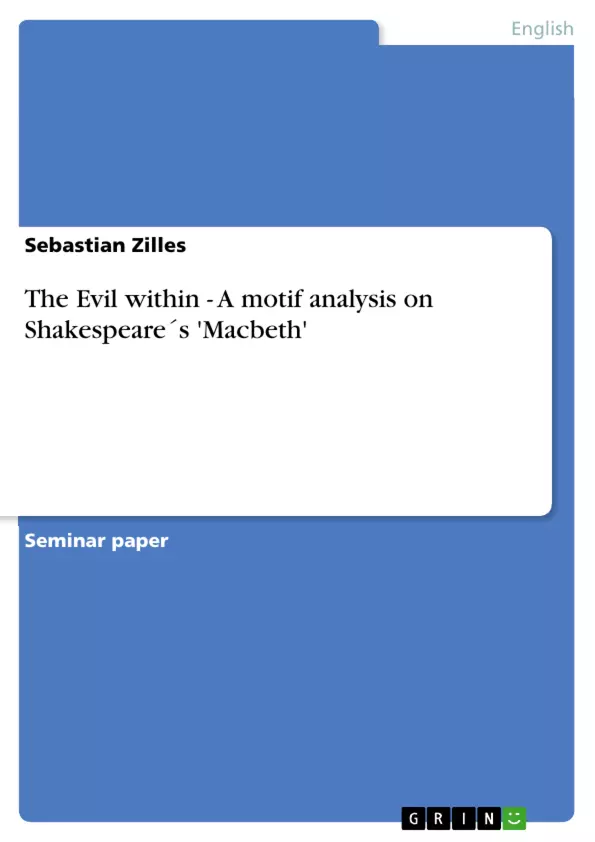Roy F. Baumeister maintains in his magnum opus 'Evil inside Human Cruelty and Violence' that the “[e]vil is always ready and waiting to burst into the world“. At first glance this statement seems exaggerated and entirely pessimistic. But today´s news demonstrate that Baumeister´s statement reflects reality: nearly every day, newspapers and TV report about death, brutal crimes, gang violence, rape victims and natural disasters. Although the evil has different faces and differs in its dimensions, it always goes along with two core aspects: harm and chaos, which cause a breakdown of the stable, peaceful and rational patterns of the ordinary life (cf. Baumeister, Evil inside Human Cruelty and Violence 5 and 69). While, on the one hand, the victims suffer, the perpetrators on the other hand derive pleasure from causing harm. Not rarely the question rises: What made these people turn to the dark and evil side?
A prominent literary example of this phenomena is Shakespeare´s tragedy Macbeth . Not only can the tragedy be seen as a setting of different degrees of the evil, it also reflects how ordinary people turn to the evil side. Therefore, the question: how does the protagonist Macbeth turn evil? will be the object of investigation.
Inhaltsverzeichnis (Table of Contents)
- Introduction:
- The Evil:
- The Evil in Etymological and Semantical Perspective:
- The Faces of the Evil or the Unseizable Horror:
- The Other versus the I:
- Text Analysis:
- The Rise and Fall of Macbeth:
- Act I (p. 95-121):
- Act V (p. 193-211): a brutal monster or just a pitiable victim?:
- The Rise and Fall of Macbeth:
- Conclusion:
Zielsetzung und Themenschwerpunkte (Objectives and Key Themes)
This paper aims to analyze the motif of evil in Shakespeare's play Macbeth by examining the character of Macbeth's transformation from a seemingly ordinary man to a ruthless tyrant. The paper explores the concept of evil itself, both in its etymological and semantical origins, and then explores the various ways in which evil is represented in the play. The paper concludes by suggesting that Macbeth's actions are not simply the result of him being inherently evil, but rather that he is transformed by the power of evil itself. The key themes explored in this paper include:- The nature of evil and its origins.
- The relationship between free will and the influence of evil.
- The psychological and moral consequences of evil.
- The tragic consequences of ambition and desire.
- The relationship between the individual and society.
Zusammenfassung der Kapitel (Chapter Summaries)
The first chapter introduces the topic of evil by drawing upon Roy F. Baumeister's theory of evil as an inherent force present within all humans. The chapter then delves into the etymology and semantics of the word "evil," exploring its historical roots and its various connotations. It argues that evil is a complex concept with multiple interpretations, and that it cannot be simply defined as the opposite of good. The second chapter explores different interpretations of the "faces of evil," examining various perspectives on how evil manifests itself. This includes the views of Annemarie Pieper, who associates evil with radical individualism, and Hannah Arendt, who proposes the concept of the "banality of evil." The chapter concludes by suggesting that evil is a multifaceted and elusive concept that cannot be easily defined or categorized. The third chapter begins the text analysis by examining the character of Macbeth's rise and fall, focusing on the contrasting elements of his personality as portrayed in Act I and Act V. The chapter explores how Macbeth's actions are shaped by the influence of evil, and how his transformation from a relatively noble figure to a ruthless tyrant is driven by his ambition, ambition that is fuelled by external forces such as the Weird Sisters.Schlüsselwörter (Keywords)
This paper explores the themes of evil, ambition, free will, guilt, power, and the human condition. It examines the tragic consequences of Macbeth's actions and the corrupting influence of evil on his character. The paper also explores the role of the supernatural in the play, particularly the significance of the Weird Sisters and their prophecies.- Quote paper
- Sebastian Zilles (Author), 2008, The Evil within - A motif analysis on Shakespeare´s 'Macbeth', Munich, GRIN Verlag, https://www.hausarbeiten.de/document/118238


